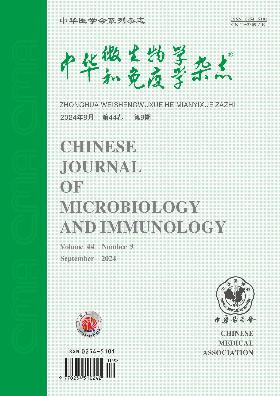qnrS1阳性大肠杆菌对喹诺酮类药物耐药性的分子特征
Q4 Immunology and Microbiology
引用次数: 0
摘要
目的分析qnrS阳性大肠杆菌对喹诺酮类药物耐药的分子特征。方法从福建医科大学附属协和医院采集57株qnrS1阳性临床分离株。通过PCR检测质粒介导的喹诺酮耐药性(PMQR)基因[qnrA、qnrB、qnrC、qnrD、aac(6′)-Ib-cr、qepA和oqxAB]和β-内酰胺酶基因(blaCTX-M-1、blaCTX-M-2、blaCTX-M-8、blaCTX-M-9、blaSHV和blaTEM),然后进行测序。采用琼脂稀释法对qnrS1阳性菌株的耐药性进行分析。利用聚合酶链式反应进行系统发育分析。进行多基因座序列分型(MLST)进行表型分析。采用肠杆菌重复基因间共有聚合酶链式反应(ERIC-PCR)评价分离株之间的遗传相似性。以耐叠氮化钠大肠杆菌J53为受体菌株,通过偶联试验检测了57株菌株携带的qnrS1基因的可转移性。通过聚合酶链式反应分析这些菌株的喹诺酮耐药性决定区(QRDR)的突变。结果所有qnrS1阳性大肠杆菌对喹诺酮类药物均表现出较高的耐药性。14株(24.6%)分离株携带PMQR基因。产超广谱β-内酰胺酶(ESBLs)的菌株占68.4%,56株(98.2%)发现gyrA、gyrB、parC和parE基因的QRDR突变,最常见的点突变是gyrA基因的S83L(89.5%)、parC基因的S80I(54.4%)和parE基因的P415V(28.1%)。qnrS1基因从13个(22.8%)分离株中通过偶联成功地转移到大肠杆菌J53中。检测到5个质粒不亲和群。系统发育分析表明,共有36株(63.2%)、13株(22.8%)、1株(1.8%)和7株(12.3%)分离株分别属于A、B1、B2和D组。根据ERIC-PCR和MLST的结果,将57株qnrS1阳性大肠杆菌分为50个ERIC型和39个序列型(ST)。结论大肠杆菌QRDR基因突变与qnrS1基因有关,可能在喹诺酮耐药菌的传播中起重要作用。关键词:qnrS;大肠杆菌;喹诺酮类耐药性;质粒介导的喹诺酮耐药性;喹诺酮类耐药性决定区本文章由计算机程序翻译,如有差异,请以英文原文为准。
Molecular characteristics of qnrS1-positive Escherichia coli resistant to quinolone
Objective
To analyze the molecular characteristics of qnrS-positive Escherichia coli (E.coli) strains resistant to quinolone.
Methods
A total of 57 qnrS1-positive clinical isolates were collected from Fujian Medical University Union Hospital. Plasmid-mediated quinolone resistance (PMQR) genes [qnrA, qnrB, qnrC, qnrD, aac(6′)-Ib-cr, qepA and oqxAB] and β-lactamase genes (blaCTX-M-1, blaCTX-M-2, blaCTX-M-8, blaCTX-M-9, blaSHV and blaTEM) were detected by PCR and then sequenced. Agar dilution method was used to analyze the antimicrobial susceptibility of the qnrS1-positive strains. Phylogenetic analysis was conducted using PCR. Multilocus sequence typing (MLST) was performed for phenotyping. Enterobacterial repetitive intergenic consensus-polymerase chain reaction (ERIC-PCR) was used to evaluate the genetic similarity between those isolates. Transferability of the qnrS1 genes carried by the 57 strains was examined by conjugation test with the sodiumazide-resistant E. coli J53 as the recipient strain. Mutations in the quinolone resistance-determining regions (QRDR) in those strains were analyzed by PCR.
Results
All of the qnrS1-positive E. coli strains showed high resistance to quinolones. PMQR genes were harbored by 14 (24.6%) isolates. Extended spectrum β-lactamases (ESBLs)-producing isolates accounted for 68.4%. Mutations in the QRDR of gyrA, gyrB, parC and parE genes were found in 56 (98.2%) strains and the most frequent point mutations were S83L (89.5%) in gyrA gene, S80I (54.4%) in parC gene and P415V (28.1%) in parE gene. The qnrS1 gene was successful transferred from 13 (22.8%) isolates to E. coli J53 by conjugation. Five plasmid incompatibility groups were detected. Phylogenetic analysis showed that there were 36 (63.2%), 13 (22.8%), 1 (1.8%) and 7 (12.3%) isolates belonging to groups A, B1, B2 and D, respectively. The 57 qnrS1-positive E. coli strains were assigned to 50 ERIC types and 39 sequence types (ST) based on the results of ERIC-PCR and MLST.
Conclusions
Mutations in the QRDR in E. coli strains were associated with qnrS1 gene and might play a critical role in the dissemination of quinolone-resistant bacteria.
Key words:
qnrS; Escherichia coli; Quinolone resistance; Plasmid-mediated quinolone resistance; Quinolone resistance-determining region
求助全文
通过发布文献求助,成功后即可免费获取论文全文。
去求助
来源期刊

中华微生物学和免疫学杂志
Immunology and Microbiology-Virology
CiteScore
0.50
自引率
0.00%
发文量
6906
期刊介绍:
Chinese Journal of Microbiology and Immunology established in 1981. It is one of the series of journal sponsored by Chinese Medical Association. The aim of this journal is to spread and exchange the scientific achievements and practical experience in order to promote the development of medical microbiology and immunology. Its main contents comprise academic thesis, brief reports, reviews, summaries, news of meetings, book reviews and trends of home and abroad in this field. The distinguishing feature of the journal is to give the priority to the reports on the research of basic theory, and take account of the reports on clinical and practical skills.
 求助内容:
求助内容: 应助结果提醒方式:
应助结果提醒方式:


